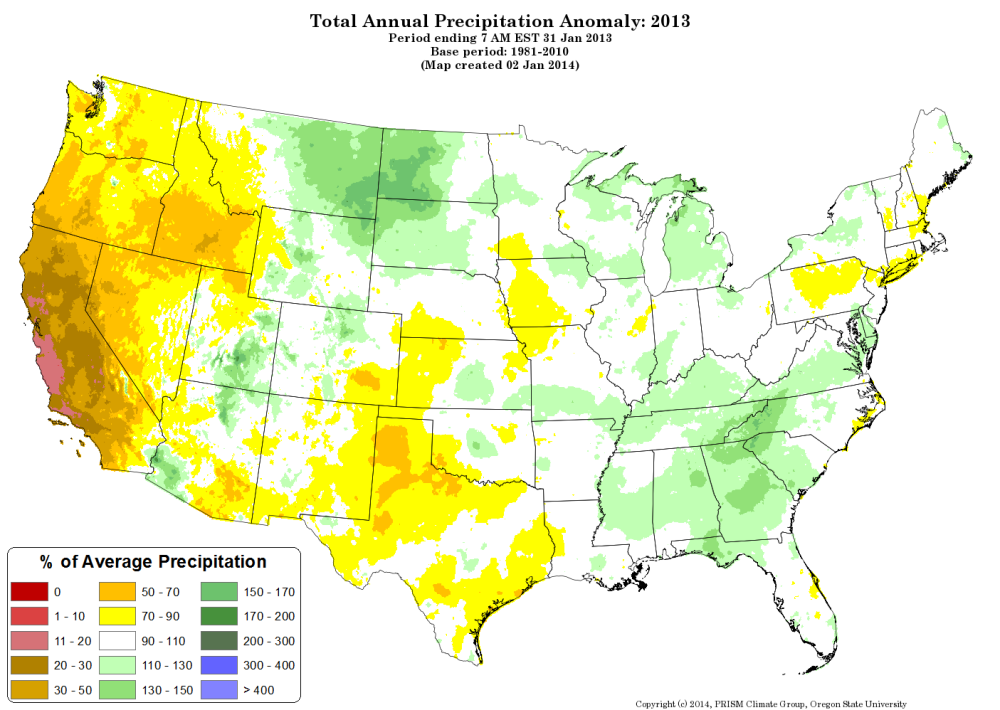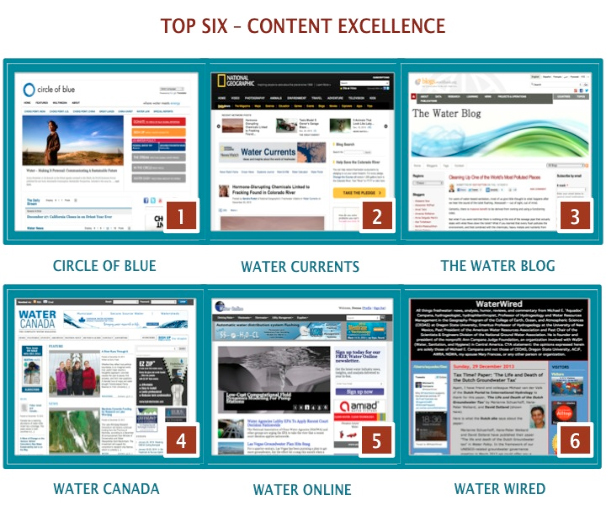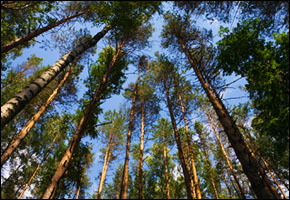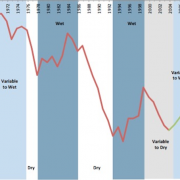California’s Historically Dry 2013 Redefines Drought
Even the soggy parts of California saw less rain than Phoenix.

Not even Nigel Tufnel’s legendary amplifiers could match the intensity of California’s 2013 drought. The lead guitarist for fictional rock band Spinal Tap claimed to turn the volume to 11, but a year of unrelenting dryness has completely changed the way drought is perceived in the nation’s most populous state.
–Steve Johnson, meteorologist
Atmospherics Group International
“The last year threw the old records out the door,” Steve Johnson, a meteorologist with Atmospherics Group International, a private weather forecasting outfit, told Circle of Blue. “On a 1 to 10 scale, 2013 was a 14 to 16. That’s how big an event this was compared to the previous drought.”
What does that off-the-charts comparison mean? It means that 2013 was an unprecedented year by an unprecedented margin, so dry that it shattered a handful of previous records by 40 to 60 percent.
For instance, average annual precipitation at San Francisco International Airport is 20.65 inches. The previous drought record was 9.22 inches in 1952. Last year, the rain gauge at the airport measured just 3.38 inches – similar to what was recorded in parts of the Mojave Desert in southern California and southern Nevada.
For most of the year a large ridge of high pressure (a “brick wall,” said Johnson) has blocked storms from the Gulf of Alaska that usually dump rain on California. Computer models do not show the wall moving much in the next two weeks – and every day counts during the winter, a critical time for building the mountain snowpack.
A New Category
An extreme event trumping an extreme event by such an obscene amount is so unusual that it left Johnson, who has studied California weather for decades, struggling to find the right words or analogies to describe it.
“It’s an entire new category of drought,” he said. “We’re in uncharted waters. It’s a Hurricane Katrina-type event for the drought field.”
On New Year’s Eve, Johnson gathered data from dozens of individual weather stations in the state to put together an annual review. What he saw pumped him so full of adrenaline that he couldn’t go to sleep.
“Every line I typed I couldn’t believe what I saw,” he said.
That same sort of insomnia will befall many in California in 2014, but for less exhilarating reasons. There are clear reasons to worry about the state’s water supply. Last year was a second consecutive drought year. State officials anticipate a third. The first snow survey of the season found the Sierra Nevada snowpack just 20 percent of normal – “more bare ground than snow,” as the Department of Water Resources put it.
Less snow means less runoff into reservoirs, which are already flagging. Storage in the reservoirs that supply the state’s two main canal systems is just 36 percent of capacity. Folsom Lake near Sacramento is less than 20 percent full, prompting water restrictions in the capital region starting in December, usually the wet season.
The Bureau of Reclamation, which manages one of the canals, has told farmers to expect just 5 percent of a normal allocation. That preliminary figure, a conservative estimate, may rise but not by much.
At the start, 2014 is not looking good for California water. Odds are, precipitation will not be as scarce as last year, but with supplies already diminished, the consequences of another dry year could be worse.
Brett writes about agriculture, energy, infrastructure, and the politics and economics of water in the United States. He also writes the Federal Water Tap, Circle of Blue’s weekly digest of U.S. government water news. He is the winner of two Society of Environmental Journalists reporting awards, one of the top honors in American environmental journalism: first place for explanatory reporting for a series on septic system pollution in the United States(2016) and third place for beat reporting in a small market (2014). He received the Sierra Club’s Distinguished Service Award in 2018. Brett lives in Seattle, where he hikes the mountains and bakes pies. Contact Brett Walton








The extreme dry spell in California and the large-scale meteorological pattern driving it are pretty incredible. There’s a long discussion on the persistence of the “Ridiculously Resilient Ridge” over the Pacific and how the present event stacks up to the 76′-’77 drought on the California Weather Blog at http://www.weatherwest.com …
The right engineering can make this happen if the corporation and private sectors gets out of the way. The Colorado River need a pipeline flowing north then down from the Missouri River into the west to end drought and flooding in the mid-east.
I agree with this plan!